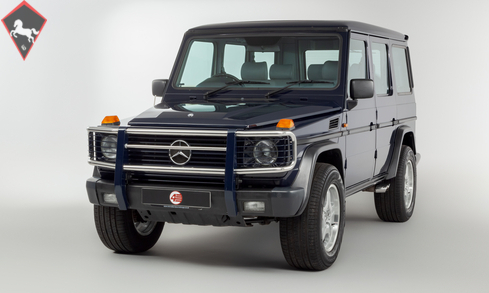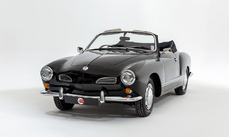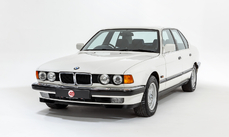Mercedes-Benz G-wagon LWB 1994
General description :
Equipment
Dark Blue paintwork, Grey MB-Tex upholstery, 5-speed manual transmission, 4-wheel drive system, 18-inch AMG alloy wheels, Enlarged track and wheel arch extensions, Electric tilt and slide sunroof, Electric windows front and rear, Electrically adjustable door mirrors, Heated front seats, Individual front arm rests, Driver’s airbag, Burred walnut interior trim, Foldaway rear seats, Bull bar, Twin side exit exhausts, Mud flaps front and rear, Central locking, Covered spare wheel.
Exterior
Finished in original MB Dark Blue (5904) this long-wheelbase G-Wagon looks great against our studio backdrop. The paintwork presents to a very good standard overall with only a few minor blemishes and age-related marks to note on close inspection. There is no damage or major wear to any of the rubber seals or black plastic trims, and the bumpers are also in fine condition. All the lights and glass remain in very good order, the side and rear windows all retaining their original Mercedes etching, the only negative to report here being a small chip on the windscreen. As a UK right-hand drive model this attractive G300 is a rare beast indeed, and rarer still in manual.
VIEWINGS WELCOME BY APPOINTMENT ONLY /// ADDITIONAL PHOTOS AVAILABLE UPON REQUEST
Interior
The hard-wearing MB-Tex in airy light grey is a nice contrast against the dark blue exterior. The upholstery is still notable supple and presents in great order throughout, even to commonly worn areas such as the armrests, the only real negative to report being a discreet split on the surface of the driver’s bolster. Glancing across the dash the burred walnut trim appears in fine order with no cracks or sun damage, and the switchgear all feels reassuringly solid to operate. The steering wheel shows no signs of heavy use and there is no damage to any of the interior trim or panels. The rear seats are perfectly presented, and in the boot area you’ll find two foldaway seats for additional passengers.
ENGINE & TRANSMISSION
Reading through the original service booklet it’s clear that the car has been well maintained throughout its life. There are 18 service stamps in the book, 17 of which are from Mercedes-Benz main dealers, and the last being from our trusted Mercedes-Benz specialist, Tim Purslow in Hook. The car has just returned from Tim Purslow following a service and check over at the current mileage; freshly MOT’d she’s good to go.
WHEELS, TYRES & BRAKES
The G300 sits on upgraded 18-inch genuine AMG alloys, all in perfect unmarked condition having only been fitted in recent years. They are shod in a matching set of 285/60 R18 Pirelli Scorpion Verde tyres, each one with plenty of tread left. The brakes have also been checked and remain in fine operational condition, bringing the car to a stop quickly and in a straight line.
History File
This rare UK-supplied manual 300 GEL was first registered in August 1994. It was supplied new by Ryebrook Cars Limited (Mercedes-Benz) and has driven only 102k miles in the hands of just 3 registered keepers. It was purchased by the current owner in 2019; he is now moving abroad and so the time has come to sell.
The accompanying History File is complete with the original Mercedes document wallet and handbooks, a number of recent invoices and some MOT certificates. Much of the car’s early paperwork has been misplaced but fortunately the original maintenance booklet is still present and correct, boasting 17 Mercedes main dealer service stamps plus 1 from our trusted marque specialist.
The service book is stamped at the following mileages: 1,780 – 7,404 – 12,797 – 17,850 – 24,171 – 30,960 – 36,256 – 42,076 – 47,442 – 55,131 – 59,740 – 65,671 – 70,798 – 77,452 – 91,915 – 99,601 – 100,738 – and most recently at 102,113 miles in November 2021.
http://www.4starclassics.com/for-sale/mercedes-g300-lwb-for-sale/
1994 Mercedes-Benz G-wagon LWB is listed sold on ClassicDigest in Kingsley by 4 Star Classics for £25995.
Car Facts
Car type : Car Make : Mercedes-Benz Model : G-wagon Model Version : LWB Engine size : 3.0 Model Year : 1994 Location : Hampshire
Sold
Seller Information
Sold
People who viewed this Mercedes-Benz G-wagon also viewed similar Mercedes-Benz listed at ClassicDigest
Other cars listed for sale by this dealer
About Mercedes-Benz
In the annals of automotive history, the journey of Mercedes-Benz is a tale that unfolds with the ingenuity of its founding pioneers. In the year 1886, Karl Benz crafted the Benz Patent Motorwagen, a creation that would go down in history as the world's inaugural automobile. Unbeknownst to him, this moment marked the genesis of what would evolve into the most illustrious premium car manufacturer globally. The financial underpinning of this pioneering venture, interestingly, was provided by Karl Benz's wife, Bertha Benz, demonstrating a remarkable partnership that would set the tone for Mercedes-Benz's legacy.A parallel narrative emerged not far away, as Daimler-Motoren-Gesellschaft, founded by Gottlieb Daimler and Wilhelm Maybach, entered the scene. In 1901, they unveiled their automobile under the now-famous moniker "Mercedes," meaning "godsend" in Spanish. This name was bestowed upon the car at the behest of Emil Jellinek's daughter, the distributor for Daimler-Motoren-Gesellschaft. The wheels of innovation were set in motion.
Fast forward to 1926, a pivotal year that witnessed the merger of Daimler with Benz & Cie., culminating in the birth of Daimler-Benz. The amalgamation saw the adoption of "Mercedes-Benz" as the distinguished trademark for their automobiles, fusing the legacies of two visionary entities into one.
Contrary to perceptions of conservatism, the trajectory of Daimler-Benz unfolds as a chronicle of industry firsts. From the introduction of the honeycomb radiator to the float carburetor, and the pioneering implementation of four-wheel brakes in 1924, Daimler-Benz consistently pushed the boundaries of automotive innovation. The diesel-powered Mercedes-Benz 260 D in 1936 marked the inception of diesel engines in passenger cars. The iconic Mercedes-Benz 300SL Gullwing made history as the first car with direct fuel injection, albeit the Gutbrod's tiny 2-stroke engine can claim precedence.
Safety innovations became a hallmark, with Béla Barényi's patented safety cell design in the "Ponton"-models in 1951, featuring front and rear crumple zones. The W116 450SEL 6.9 saw the introduction of the Anti-Lock Brake system (ABS), another pioneering safety feature. From the first production airbags and beyond, the legacy of "firsts" continued to be etched into the fabric of Daimler-Benz.
Over its centennial journey, Mercedes-Benz has not merely produced cars but has sculpted automotive icons. The SSKL, 710 SSK Trossi Roadster, 770K Grosser, 540K Spezial Roadster, 300SL Gullwing, w100 600 Pullman, w111 280SE 3.5 Flachkühler, w113 230SL Pagoda, w109 300 SEL 6.3, and w201 2.3-16 Cosworth stand testament to the brand's commitment to engineering excellence.
The roaring Silver Arrows, or "Silberpfeile," including the W 25, W 125, W154, W165, and W196, created a legacy of dominance on the racetrack. These machines were not merely cars; they were expressions of precision, speed, and an indomitable spirit that left their competitors in the dust.
As Mercedes-Benz marches into the future, it does so not just as an automaker but as a custodian of a legacy, a torchbearer of innovation, and a beacon of automotive excellence. The road ahead is sure to witness the continued fusion of cutting-edge technology, timeless design, and an unwavering commitment to setting new standards in the world of automobiles.
One luminary figure who left an indelible mark was Béla Barényi, often heralded as the "father of passive safety" for his pioneering work in safety engineering. His patented safety cell design, featuring front and rear crumple zones, became a hallmark of Mercedes-Benz's commitment to occupant safety, setting new standards that reverberated throughout the automotive world.
Moving through the chronicles, the collaborative genius of Wilhelm Maybach, alongside Gottlieb Daimler, laid the foundation for Daimler-Motoren-Gesellschaft. Their innovations not only birthed the first Mercedes but established a culture of relentless pursuit of technological excellence that remains integral to Mercedes-Benz's DNA.
In the post-merger era of 1926, Ferdinand Porsche emerged as a prominent figure within Mercedes-Benz. His work on the Mercedes-Benz S-Type, a supercharged race car, garnered acclaim and set the stage for a legacy that extended far beyond the marque. Porsche's impact would later extend to his eponymous company, but his influence at Mercedes-Benz during those formative years was pivotal.
As the 20th century progressed, the legendary Rudolf Uhlenhaut emerged as a key figure. Uhlenhaut, an accomplished engineer and the driving force behind the iconic Silver Arrows, played a crucial role in Mercedes-Benz's dominance in motorsports. His engineering prowess and attention to detail were instrumental in creating some of the most formidable racing cars of the era.
In the latter half of the century, figures like Bruno Sacco, the head of design at Mercedes-Benz from 1975 to 1999, left an indelible imprint on the brand's aesthetic identity. Sacco's design philosophy, characterized by clean lines and timeless elegance, shaped iconic models like the W126 S-Class and the W201 190E, solidifying Mercedes-Benz's reputation for luxury and sophistication.
The narrative would be incomplete without acknowledging the contributions of engineers like Hans Scherenberg, whose leadership in the 1970s ushered in a new era of technological innovation at Mercedes-Benz. Scherenberg's tenure saw the development of groundbreaking technologies, including the Anti-Lock Brake system (ABS) and the introduction of airbags in production cars.

























